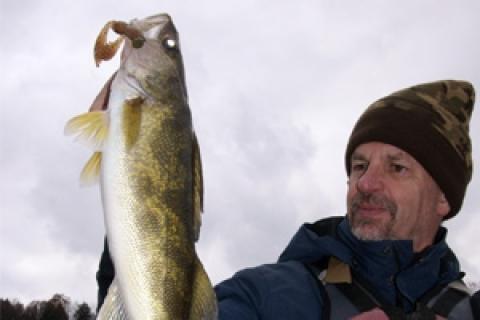
 My partner Tom Ference flipped his crawfish-imitating soft plastic jig into a quiet, bank-side pool of the Allegheny River. A moment later he had a strong tap. Following a hookset and a strong but short battle, a nice walleye was in the net.
My partner Tom Ference flipped his crawfish-imitating soft plastic jig into a quiet, bank-side pool of the Allegheny River. A moment later he had a strong tap. Following a hookset and a strong but short battle, a nice walleye was in the net.
On a list of walleye food sources, crawfish are probably down the list a ways. According to traditional thinking, walleyes eat minnows, and nightcrawlers, and leeches. To score on walleyes, you need to fish live baits within such a framework. My experience, though, indicates that walleyes, river-dwelling ones in particular, respond well to soft plastic baits that mimic a variety of natural forage.
A bit later in the day I was fishing a Texas-rigged tube jig when another walleye in the 22-inch range inhaled it. I once heard a widely acknowledged upper Midwest TV angler say walleyes rarely hit tube jigs. Maybe that's true in Minnesota, but in northwestern Pennsylvania they do. Over the years I've taken many river walleyes on tubes, including the ones I caught on last Sunday's trip.
What tubes represent to a gamefish is somewhat of a guess. It probably depends on the situation in which they are being fished. In most instances, though, the nod typically goes to crawfish.
Thin-bodied tubes like Bass Pro Shops' Tender Tube are ideal cold water tube baits. At this time of year the fish are lethargic. The water temperature during this trip was 46 degrees. Thin tubes collapse easier than thicker versions — which exposes the hook — resulting in more consistent hooksets during late fall fishing.
As the day wound down we did a drift along a rocky bank near the boat ramp. While the T-rigged tube had accounted for a couple nice walleyes along with several big smallmouth bass, I opted for a finesse sized grub, about 2.5 inches in length. It is often effective for catching smallmouth bass when they are in a somewhat subdued mood. So it was smallmouth bass I had in mind as a worked the bank as the boat drifted along. We'd just passed a shoreline laydown when my leadhead jig-rigged grub received a sharp tap. Rather than the smallmouth I'd expected to see, though, a 23-inch walleye was soon sloshing on the surface.
So the day revealed several things: one, walleyes respond well to soft plastic baits, including non-traditional offerings such as crawfish profiles, tubes, and tiny grubs. Secondly, cooling water combined with higher flows moves walleyes into areas where they are easier to contact. More specifically, this means protected pockets out of the river's main flow. Also, come late fall walleyes will be mixed with smallmouth bass; it's common to catch both species fishing the same area with the same baits.
- 4841 views

